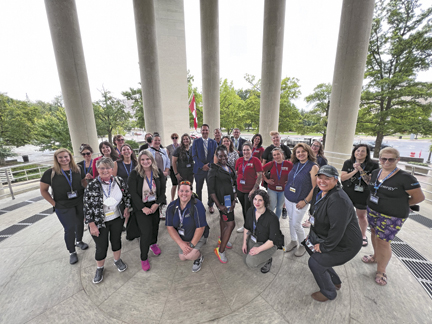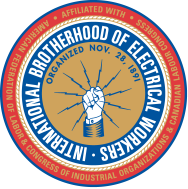Canadians attending the IBEW Women’s Conference in Washington, D.C., weren’t going to be outdone when it came to rubbing shoulders with the capital city’s movers and shakers.
While their American sisters met with lawmakers on Capitol Hill on Sept. 7, a northern delegation of 30 members took a VIP tour of their nation’s embassy and chatted with Canada’s first woman ambassador to the United States.
“It was an incredible experience,” said Marina Luporini, an assistant business manager at Vancouver, British Columbia, Local 258. “I was a little starstruck. I think it was the highlight of the conference for me.”
Her Local 258 colleague Dayna Gill, also an assistant business manager and chair of the local’s women’s committee, agreed. “For us, visiting the States and seeing another woman from Canada in a position of leadership was very inspiring,” she said.
Ambassador Kirsten Hillman, a diplomat with years of experience as a global trade negotiator, was appointed in March 2020. But she didn’t dwell on her bona fides with the IBEW guests.
“She wanted to walk around the room and meet our members and find out more about their industries. She was especially interested in some of the non-traditional roles for women,” said Cheryl Paron, a First District international representative in the Civic and Community Engagement Department.
The embassy itself also wowed the visitors, who were honored to be the first group to tour it since the COVID-19 pandemic began.
Right away, they were struck by its size and modernist grandeur, as well as its prominent location on Pennsylvania Avenue a block north of the National Mall. It is the only embassy between the Capitol and White House.
“It didn’t really feel like an embassy,” Paron said. “The artwork and the architecture, it was just beautiful. It represented Canada well, including honoring our indigenous people.”
The original Canadian embassy was nestled with other consulate mansions in Washington’s hilly northwest in a house purchased from the widow of a financier who died on the Titanic.
By the late 1960s, diplomats badly needed more space. The premium downtown parcel, home to a Ford showroom in the early automobile age, was vacant, and the U.S. offered it to Canada for the relative bargain of $4.5 million.
Built of unpolished Canadian marble, the exterior features a waterfall; a statue of the mythical Spirit of Haida Gwali, once pictured on $20 bills; and 12 pillars representing the nation’s 10 provinces and two original territories. An emblem was added when Nunavut became a separate territory in 1999.
Inside, the group strolled past a wealth of museum-quality Canadian artwork and other treasures, including hockey jerseys signed by famed players.
Meaghan Olmstead, assistant business manager of Local 2228 in Ottawa, took special note of the embassy’s commitment to the environment.
“My background is in renewable energy, so I was really pleased to see the LEED platinum certification, the highest rating for green buildings,” Olmstead said. “The whole embassy is really renewable and green, so that was big for me.”
 The tour was such a source of pride that the Canadians broke into song amid the outdoor pillars. Known as the Rotunda of the Provinces, it harbors an acoustical secret under its domed roof.
The tour was such a source of pride that the Canadians broke into song amid the outdoor pillars. Known as the Rotunda of the Provinces, it harbors an acoustical secret under its domed roof.
“It kind of echoes your voice back to you,” Luporini said. “The entire group of us stood there and belted out ‘O Canada.’ It felt so patriotic.”
Paron, who helped set up the tour a month in advance, said it was even more meaningful that she’d imagined.
“It wasn’t just another government building in Washington, it was our building, and it was so important to see ourselves and our history reflected in it,” she said. “It was just really cool to have a little piece of Canada with us while we were at a conference in the United States.”



